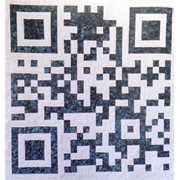In the beginning of 2005, I started quilting.
I joined a guild. I read books. I started a business.
And quilted.
I quickly discovered how difficult it is to line up all the little seamlines that are formed when piecing a quilt top.
Especially triangles. Triangles are a bitch.
So now it's about 5.5 years later, with many, many mistakes under my belt, that I have now mastered the art of the f**g triangle, getting my squares that are formed from 4 triangles to go together nicely, evenly, with seamlines neatly lined up,...
... and effortlessly.
You see, there's a TRICK to it.
Now I've seen entire tv shows devoted to the art of triangles and getting the seamlines lined up.
I've read books describing how to plan ahead and press the seamlines in opposite directions.
I've attended no fewer than three hour-long workshops devoted entirely to the art of getting the stupid seamlines on your triangles to line up when you sew them.
Imagine my astonishment this morning then, when I figured out the trick. THE trick. The one that actually works. The one that, when you take all these squares you've put together with triangles and try to sew the edges together, makes all the seamlines lie flat, with all the points meeting properly.
And why am I not surprised nobody has thought to tell this particular little secret?
Okay - picture this. You start with a square bigger than you need. Four squares, actually. I want my squares to finish at 5 inches. I cut the squares at a whopping SEVEN inches.
(No that's not the trick.)
You mark the diagonal, you sew two squares right-sides together, sewing on either side of the line, in a 1/4-inch seamline. Then you cut the squares apart and do the same for the other two squares.
This gives you four half-square triangles sewn into 2 squares.
Seasoned quilters are yawning at this point. Yeah, yeah, tell me something I don't know.
You press the seams on each square to the darker side. Nothing new here. You flip the two squares right sides together and mark the other diagonal and sew two seams, 1/4 of an inch to each side of the line. You cut them apart on the line, you press 'em open, bingo, you have two squares, each made up of 4 triangles. And then you trim them to the size you want.
Everybody who has ever attended a triangle workshop now has their eyes rolling to the back of their heads. *S N O R E .
Here comes the fun part, the part they don't tell you about. Now you have to sew these two squares together, matching those diagonal seamlines. You have two seams to traverse, four thicknesses of material in each one. If you're very, very lucky, one of these sets of seams will have been pressed in opposite directions, meaning the two halves of the fabric are lying opposite to each other, and you can sew a very flat seam indeed.
Never, ever have I heard of a trick to get both sets with their seamlines pressed in opposite directions.
Well, you heard it first here, folks.
Guess what - even if none of the seams have been pressed in opposite directions, you can still do it.
You do it there, at the machine. You physically push either the top or the bottom seam to one side.
You fudge it.
You say "f**k it - I'm sick of all this geometry - I'm just gonna sew you together and pretend I had pressed you in opposite directions. Take that!"
And you open up the side you've just sewn, and both points line up perfectly.
Want me to run you through that again?
No, you don't have to know which seamlines will be up and which seamlines will be down 60 steps in advance of putting them together. You take your two squares, and if the seams have been pressed in opposite directions, well and good, go ahead and sew.
But if they haven't been pressed in opposite directions, you pick one, you finger-press it into place, and you sew it down.
"But," you'll complain, "won't that leave the seamline of one side sewn facing one way at one end and facing the other way at the other end?"
Yes. It will.
And so what? You press it with a crick in it and get on with your quilt. We've all seen plenty of turned seams on the backs of quilts. There a small bump? Quilt it down.
By the time you've added batting and backing, it won't matter one whit which way any seam was facing.
Because your points all line up.
So there you have it. You fake it. You fudge it. You grab one end or the other and make it lie flat.
You don't tell a soul, you don't write a book, and you certainly never let on to other quilters what you did to get all those little points to line up.
Believe me, this is a professional tip!
Unbelievable!






No comments:
Post a Comment